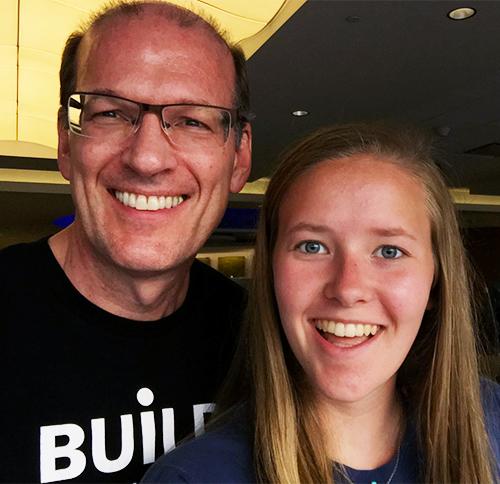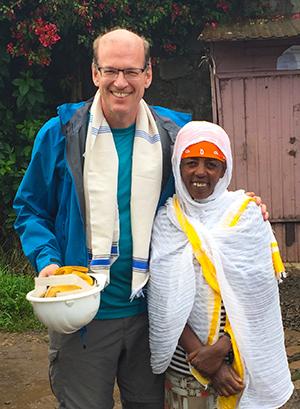Ethiopia: Jonathan Reckford travels to build
After months of anticipation — and yet not having time to think too much about a trip I still considered far into the future — I am boarding a plane with my daughter for Ethiopia. We are heading to Addis Ababa on a Habitat for Humanity Global Village volunteer trip to help families improve their living conditions.

Among those joining us are some of my classmates from the Stanford Business School and their families. We are anxious to meet up with the whole team of 21 people who will experience firsthand how Habitat helps families build strength, stability and self-reliance. Although I have been to Africa many times, this will be my first trip to Ethiopia.
Our tasks in the area in which we will be working will include building a small community bathroom and upgrading some housing. The conditions in which many people in our host community of Gullele live are wildly inadequate. In fact, the vast majority of Ethiopians live in poorly built, overcrowded houses that are falling apart and lack even the most basic facilities, such as toilets and running water.
We have a great Habitat program in the country, however, and I’m excited about the increasing impact we are having in communities there. We’ve been building in Ethiopia since 1993 and have helped thousands of families through our diverse and innovative program, which is tailored to meet the local housing need.
Too often, I only get to visit briefly with Habitat homeowner families at a dedication ceremony or during a quick tour of a community, so these build trips are a real treat for me. I get to spend a week working alongside families in other parts of the world who are eager to build a better life. This recharges my batteries and makes our mission so real to me all over again.
I’m also delighted that I can spend time with my daughter. It’s a great way both for us to create some memories and for her to better understand what I do and what Habitat does. When Lily was in elementary school and I was in the corporate world, when asked what her dad did for a living, she would say he goes to the office and works on computers. These trips have given her such a great appreciation of and shared passion for Habitat’s work.
It will take most of two days to get there but I can’t wait to see what God has in store for us in the coming week.

I am so excited to be in Ethiopia, a country with such an extraordinary history — a place called the cradle of mankind.
Of all the countries in which Habitat works, it’s in Ethiopia that we see some of the deepest housing need. Most of the population lives on less than US2 a day. Eighty percent of the population of Addis Ababa, where we’re working this week, lives in slum conditions.
On the first day of construction, we helped one group of 13 families construct an eight-seat communal toilet and another group of five families build a four-seat toilet. Fewer than 30 percent of families in Ethiopia have access to any kind of sanitation. It’s hard to contemplate the lack of dignity and privacy or the health impact these families experience from such a lack of facilities.
Habitat Ethiopia works with the administration of the warida, or county, on a process for selecting the most vulnerable or marginalized families. The monthly income of the people we worked with was between 18 and 32 dollars. Once the families are selected, they begin a process of saving four cents per family per month to fund the maintenance of the toilets (managed by the families) and emptying of the septic tank.
Before we arrived, Habitat Ethiopia helped the families assure secure tenure of the land. We built and poured the foundations on Monday and returned Wednesday to build the walls of the communal toilets. Four of us moved three tons of concrete blocks and 100 wheelbarrows of sand up a hill. That was the hardest day’s work I’ve done in a long time.
We were all amazed and humbled by the energy and commitment of the families we worked alongside. One woman, Aynalem — I would guess that she’s in her sixties — never rested for a moment from carrying gravel and sand for mixing cement or helping with the bucket brigade to pour the foundation. There was a wonderful sense of solidarity that is the hallmark of Habitat.
On Tuesday, we worked in a small compound of families renovating two houses and framing the walls of a new home. We were building chika houses by constructing a frame from eucalyptus logs and then lashing split eucalyptus branches to create the walls. The next step is to plaster the frames on both sides with the chika mixture of clay and straw, which is fermented. The chika, cured properly, creates a strong and durable wall at a low cost.
In this case, we will also put on a thin coating of cement plaster to seal the walls and make them watertight. We moved a small mountain of large rocks to lay the foundations for the renovated homes, which will have cement floors for the first time.
I particularly enjoyed talking to Amsele, a tenth grader who wants to study medicine. Yoseph, our program manager, told me he first met Amsele when they did the home visit. It was pouring rain, and water was coming in all around her in the one-room shack her family was living in. She was crouched on a box trying to keep her book dry and get her homework done. A new home won’t solve all of the challenges Amsele faces, but it will give her a safe, dry place to study for the first time. She’s a strong student and hopes to go to university.
What a lovely closing ceremony we enjoyed with several families.
I also had a chance to stop by the Habitat Ethiopia office and meet and thank the rest of the staff. I was moved to see the commitment and passion our team has here to improve the conditions in their country.
Time is going too quickly, but the group has come together well, and we’ve all been moved and are thrilled to be here.
Subscribe to our monthly newsletter
Get the latest Habitat news, volunteer opportunities, DIY tips and more ways to get involved.
